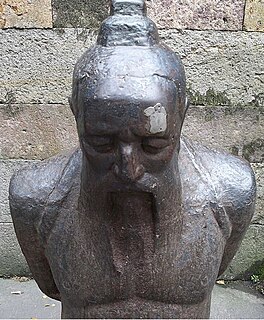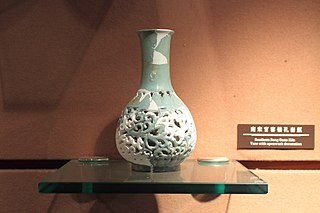
The Grand Canal, known to the Chinese as the Jing–Hang Grand Canal, a UNESCO World Heritage Site, is the longest as well as the oldest canal or artificial river in the world. Starting at Beijing, it passes through Tianjin and the provinces of Hebei, Shandong, Jiangsu and Zhejiang to the city of Hangzhou, linking the Yellow River and Yangtze River. The oldest parts of the canal date back to the 5th century BC, but the various sections were first connected during the Sui dynasty. Dynasties in 1271–1633 significantly rebuilt the canal and altered its route to supply their capital Beijing.

Jiangnan or Jiang Nan is a geographic area in China referring to lands immediately to the south of the lower reaches of the Yangtze River, including the southern part of its delta. The region encompasses the city of Shanghai, the southern part of Jiangsu Province, the southeastern part of Anhui Province, the northern part of Jiangxi Province and the northern part of Zhejiang Province. The most important cities in the area are Anqing, Changzhou, Hangzhou, Nanjing, Ningbo, Shaoxing, Suzhou, Wuxi, Wenzhou, Zhenjiang and Fuzhou.

Beihai Park is a public park and former imperial garden located in the northwestern part of the Imperial City, Beijing. First built in the 11th century, it is among the largest of all Chinese gardens and contains numerous historically important structures, palaces, and temples. Since 1925, the place has been open to the public as a park. It is also connected at its northern end to the Shichahai.

Huìzhōu is a city in southeast Guangdong Province, China. It forms part of the Pearl River Delta megalopolis. Huizhou borders the provincial capital of Guangzhou to the west, Shenzhen and Dongguan to the southwest, Shaoguan to the north, Heyuan to the northeast, Shanwei to the east, and Daya Bay of the South China Sea to the south. The city has about 4.6 million inhabitants and is administered as a prefecture-level city.

Wuyue, 907–978, was an independent coastal kingdom founded during the Five Dynasties and Ten Kingdoms (907–960) of Chinese history. It was ruled by the Qian family, whose family name remains widespread in the kingdom's former territory.

Kunming Lake is the central lake on the grounds of the Summer Palace in Beijing, China. Together with the Longevity Hill, Kunming Lake forms the key landscape features of the Summer Palace gardens.
The history of Chinese cuisine is marked by both variety and change. The archaeologist and scholar Kwang-chih Chang says “Chinese people are especially preoccupied with food” and “food is at the center of, or at least it accompanies or symbolizes, many social interactions.” Over the course of history, he says, "continuity vastly outweighs change." He explains basic organizing principles which go back to earliest times and give a continuity to the food tradition, principally that a normal meal is made up of grains and other starches (simplified Chinese: 饭; traditional Chinese: 飯; pinyin: fàn) and vegetable or meat dishes.

Liuhe Pagoda, literally Six Harmonies Pagoda, is a multi-story Chinese pagoda in southern Hangzhou, Zhejiang province, China. It is located at the foot of Yuelun Hill, facing the Qiantang River. It was originally constructed in 970 by the Wuyue Kingdom, destroyed in 1121, and reconstructed fully by 1165, during the Southern Song dynasty (1127–1279).

A Chinese palace is an imperial complex where the royal court and the civil government resided. Its structures are considerable and elaborate. The Chinese character gong represents two connected rooms (呂) under a roof (宀). Originally the character applied to any residence or mansion, but it was used in reference to solely the imperial residence since the Qin Dynasty.

Qin Hui or Qin Kuai was a Chinese politician. He was a Chancellor of the Song dynasty in Chinese history. He is widely regarded as a traitor for his part in the persecution and execution of his political enemy, Yue Fei, a general who fought for the Song against the Jin dynasty during the Jin–Song Wars, resulting him being condemned by later generations of being corrupt. Modern historians, however, have placed as much blame on the reigning Emperor Gaozong himself. He was also nicknamed "Long-legged Qin" by the people out of scorn.

Archaeological excavations at the Tiger Cave Kiln at Hangzhou in the Chinese province of Zhejiang have helped to identify one site of origin of the important ceramic wares of the Southern Song dynasty known as Guan ware, meaning "official" ware, which were made for the exclusive use of the imperial court.
Jingci Temple is located at the foot of Huiri Peak of Nanping Hill. It is the second prominent Buddhist temple beside West Lake in Hangzhou, China. Together with Lingyin Temple, it is called the jewel of the southern and northern hills. The temple was claimed as a key national Buddhist temple in Han areas by the State Council in 1983.
Huajiachi is a lake in Hangzhou, Zhejiang, China.

The Dragon Pavilion, Longting or Wanshou pavilion is located in Kaifeng in the eastern part of Henan province, People's Republic of China. During the Northern Song (960–1127) and Jin (1115–1234) dynasties, Kaifeng was an imperial capital city. The imperial palace of that time is largely lost to time, but a few parts, such as the Dragon Pavilion, remain visible today.

Fengguan is a traditional type of Chinese headgear for women. It was worn mainly by noblewomen during the Ming dynasty for ceremonies or official occasions. It is also traditional headgear for brides.

The Yue Fei Temple or commonly known in Chinese as Yuewang Temple is a temple built in honour of Yue Fei, a general of the Southern Song dynasty who fought against the Jurchen Jin dynasty during the Jin–Song Wars, after the capital of China moved south to Hangzhou. The temple ground is located near the West Lake, in central Hangzhou.

Taiye Lake or Pond was an artificial lake in imperial City, Beijing during the Jin, Yuan, Ming, and Qing dynasties of China. The beauty and utility of the lake was responsible for the siting of Kublai Khan's palace and the position of modern Beijing. It continues to exist but it is now known separately as the "North", "Central", and "South Sea"s, the three interconnected lakes just west of the Forbidden City in downtown Beijing. The northern lake makes up the public Beihai Park while the southern two are grouped together as Zhongnanhai, the headquarters for the Communist leadership of the People's Republic of China.

The Qiantang River is a river in East China. An important commercial artery, it runs for 459 kilometers (285 mi) through Zhejiang, passing through the provincial capital Hangzhou before flowing into the East China Sea via Hangzhou Bay.





















